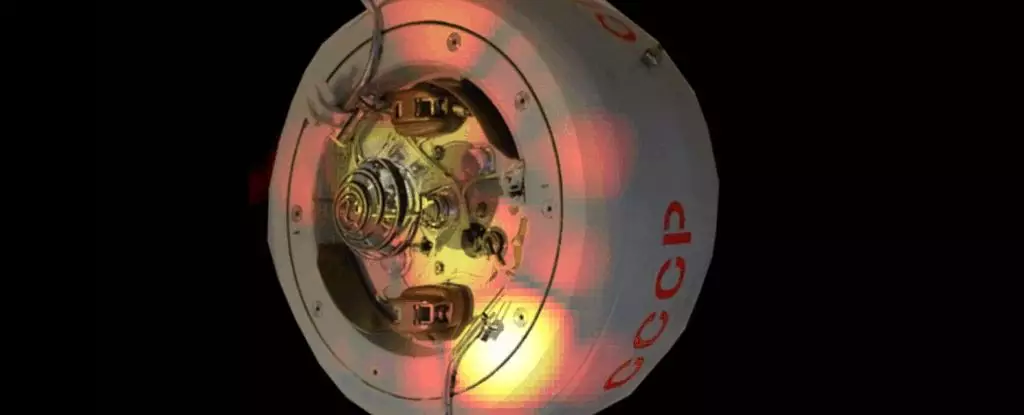Fifty years ago, amid the fervor of the Cold War and space race, the Soviet Union launched an ambitious endeavor that would forever change our understanding of space exploration. The Venera program, aiming to unveil the secrets of Venus, marked humanity’s first successful venture to land spacecraft on a planetary body other than Earth. However, of the 29 Venera probes sent on this pioneering mission, only 16 made it to the surface or successfully orbited Venus. The remnants of these missions serve as powerful symbols of human aspiration, eternal mysteries stuck in a cosmic drama that cosmic watchers can only admire from afar.
Kosmos 482 is one such spacecraft whose storied past has recently re-emerged in the spotlight. Launched in 1972, this probe spent an unprecedented 53 years caught in the gravitational embrace of Earth. Eclipsed by more successful missions and left to drift through the abysses of space, it was while tumbling through the ether that it ignited renewed interest and fascination when it finally met its fate in May 2025.
The Thrilling Climax of a Long Journey
On May 10, 2025, the long-dormant Kosmos 482 made its dramatic reentry into Earth’s atmosphere. The probe, which was designed with the intent to explore Venus, instead became a spectacle as it plummeted through the skies. This fall captured not only scientific interest but also a sense of nostalgia—an inevitable reminder of the ambitions and technological prowess of an era now studied through the lens of modern advancements.
According to observations from the Fraunhofer Institute, the spacecraft was last spotted over Germany, leading to speculation about its descent trajectory. Despite extensive monitoring efforts from agencies like the European Space Agency (ESA), precise details surrounding its landing location remain shrouded in uncertainty—likely deep within the Indian Ocean. This adds a layer of intrigue to its final chapter, leaving the world to wonder if relics of the Soviet space mission now lie in the depths of one of Earth’s mysterious waters.
The Hellish Landscape of Venus
As we marvel at the tale of Kosmos 482, it’s crucial to revisit the planet it sought to explore—a world whose wrath makes even the boldest of human ambitions seem trivial. Venus is not just a celestial body; it is an unforgiving environment, with surface temperatures that soar to around 464 degrees Celsius (867 degrees Fahrenheit) and atmospheric pressure 92 times that of Earth. Add to this the noxious rain of sulfuric acid, and it’s easy to see why the Venera probes required exceptional engineering to withstand such hellacious conditions.
The dramatic nature of Venus underscores why the Venera program’s accomplishments are still celebrated. Each mission was an exercise in human ingenuity against overwhelming odds, creating dependable spacecraft capable of enduring extreme environments. Kosmos 482, despite never reaching its intended destination, stands as a testament to the mission’s ambition, representing the unyielding quest for exploration.
A Reflection on Space Debris
The return of Kosmos 482 to the Earth’s atmosphere invites us to confront an urgent topic within the realm of space exploration: the growing issue of space debris. This legacy of failed missions and defunct objects in orbit poses not only a potential collision threat to active satellites but also represents humanity’s ongoing struggle with the responsible usage of our celestial highways.
As technologies have evolved, advocacy for the Design for Demise philosophy has emerged—a concept which emphasizes creating spacecraft that will disintegrate harmlessly upon reentry rather than leaving behind pieces that might unsafe conditions for future missions. Unfortunately, not all manufacturers heed this guidance, continuing to launch spacecraft at an unsustainable pace. The relics of past missions linger, destined to eventually reenter Earth’s atmosphere, prompting reflections on the ethics of space exploration.
The Collective Responsibility of Humanity
With the tale surrounding Kosmos 482 now capturing international attention, it serves as both an exhilarating account of our space-faring endeavors and a sobering reminder of our responsibilities as stewards of space. The story of its unintended reentry exemplifies the thin line we walk between progress and negligence, invoking questions about how we approach the exploration of the final frontier.
As we gaze into the cosmos, pondering our next steps towards interplanetary exploration, we must also choose humility. The weight of our legacy on this planet and beyond urges us to make thoughtful and sustainable choices for future explorers. The journey of Kosmos 482, while marred by a lack of success in its original mission, poses a profound challenge for our era: how will we learn from the past as we navigate the uncharted territories of tomorrow? The answer may shape our relationship with the stars long into the future.

